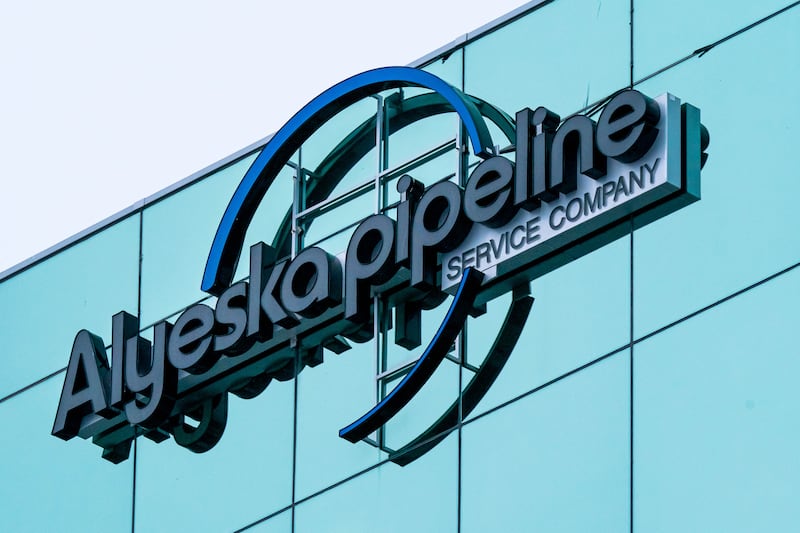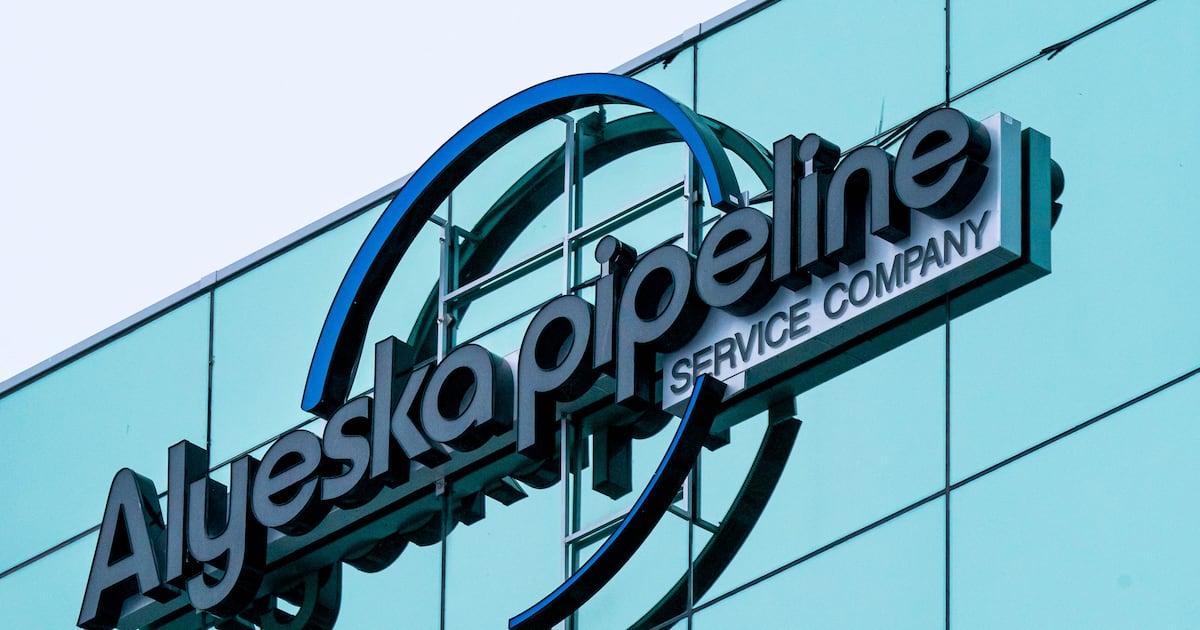 A sign for Alyeska Pipeline Service Company is seen on an office building in Midtown Anchorage on Thursday, March 30, 2023. (Loren Holmes / ADN)
A sign for Alyeska Pipeline Service Company is seen on an office building in Midtown Anchorage on Thursday, March 30, 2023. (Loren Holmes / ADN)
The operator of the trans-Alaska pipeline will reduce its workforce, becoming the second major company in Alaska’s oil industry recently to disclose plans for staff reductions.
The layoffs come as some major companies are cutting workers globally amid relatively low oil prices.
Alyeska Pipeline Service Co., which operates the 800-mile Alaska pipeline, notified employees last month that it was conducting a review of the company and planned to trim its workforce by about 60 positions, said Michelle Egan, a spokeswoman with Alyeska Pipeline, in an interview Friday.
The figure represents about 8% of the company’s total workforce, which is around 700, she said.
The actual number of employees ultimately reduced will be fewer than 60, in part because some positions are not filled and some employees will shift roles, she said. Egan declined to say Friday how many Alyeska Pipeline employees will be affected, or in what operational areas the cuts will occur.
The staff reductions are designed to make Alyeska Pipeline more efficient, Egan said.
“This is always tough and it’s hard on people that are leaving the company,” Egan said. “This is our work family, and we are really committed to each other here. These are difficult decisions.”
ConocoPhillips, the state’s top oil producer, also disclosed this week that it has sent layoff notifications to some employees at its North Slope oil fields in northern Alaska.
ConocoPhillips did not specify the number of notices it issued in Alaska, saying it won’t provide the number of cuts in regions where it operates.
It also cited a need for more efficient operations when it announced last month that it will cut up to a quarter of its workforce globally, representing 3,250 workers.
Global workforce reductions are also being undertaken by ExxonMobil and Chevron.
The industry layoffs come amid a period of relatively low oil prices that have been linked to President Donald Trump’s global trade war and increased supply from the Organization of the Petroleum Exporting Countries, national news outlets have reported.
Egan said Alyeska Pipeline will provide more details of the changes to employees in a town hall meeting planned for Monday afternoon. The meeting will be held online and is part of the company’s quarterly virtual town halls that include all employees, she said.
Egan said the company is continually looking to improve operations and has taken steps in the past to reduce staff.
A larger reduction came in 2018 when Alyeska Pipeline’s president at the time said the company would cut roughly 10% of the workforce.
Egan said Alyeska Pipeline will maintain safe operations after the workforce reductions.
“There’s been a lot of focus on looking at the risk associated with change and making sure we mitigate that risk,” she said. “We are not backing away from our strong commitment to safety and protecting our employees and the environment, as well as maintaining reliability, which is every barrel delivered on time.”
Alyeska Pipeline Service Co. oversees the operations that deliver North Slope crude oil down the pipeline and into oceangoing tankers in Valdez in Southcentral Alaska.
In recent years, it has delivered about 470,000 barrels of oil daily to market. It recently marked 19 billion barrels delivered since it operations began in 1977.
[A feud is escalating over Big Oil’s plans to protect Prince William Sound from another spill]
The company is owned by subsidiaries of Hilcorp, ConocoPhillips and ExxonMobil, Alaska’s major oil producers.
Alyeska will not need to file a “WARN notice” with the state of Alaska about the layoffs, Egan said.
Such notices provide the public with details about large layoffs, including the number of employees and positions. The notice is only required if the layoffs are significant enough, under the U.S. Worker Adjustment and Retraining Notification.
Alaska’s oil industry workforce has grown in recent years with major new fields under development.
Employment rose to about 8,800 in August.
That’s about one-third higher than five years ago, when the pandemic led to layoffs, but below the roughly 10,000 workers employed in 2019.
The industry is the highest-paying in the state, with average annual pay at nearly $180,000.
Partly for that reason, the state pays close attention to trends in the industry, said Dan Robinson, research chief at the Alaska Department of Labor and Workforce Development.
But too little is known about the proposed cuts, including numbers and location of workers, to begin to guess what the impact might be on the economy, Robinson said.
The agency will learn more in the coming months as companies report unemployment insurance data to the state, Robinson said.
